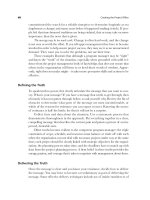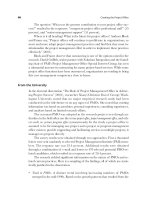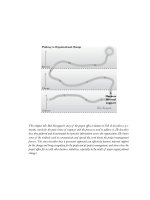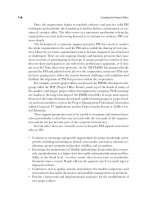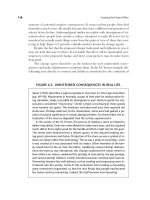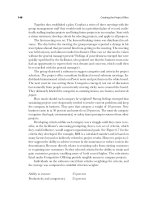Creating the project office 19
Bạn đang xem bản rút gọn của tài liệu. Xem và tải ngay bản đầy đủ của tài liệu tại đây (120.53 KB, 10 trang )
team interaction. The second day involved a forum of discussions regarding the
role of BSI. It focused on the challenges to obtain timely and accurate informa-
tion. The event was hailed as a milestone in developing effective relations between
BSI team members and clients.
This case illustrates the role of a project office with the project portfolio plus
a start-up process for managing expansion into a new territory.
Start-Up Example: Brazil in Action
In August 1996, the Brazilian government launched a program of forty-two strate-
gic projects designed to promote sustainable development and new investments,
and to reduce social inequities. In early 1999, that program increased to fifty-eight
projects.
During the first four years, approximately R$70 billion (US$35 billion) was
invested in the projects, with over 60 percent going toward improving the social
welfare of the population and the remainder aimed at infrastructure projects. The
key strategies for the program included careful selection of projects, use of project
management approaches, and partnering agreements between the government
and the private sector. Of the forty-two initial projects, twenty-five met or ex-
ceeded initial objectives at the end of the four-year period.
The projects chosen included those with a high probability of creating a more
competitive economy, reducing production and commercial costs, eliminating bot-
tlenecks, and improving qualifications of the labor force.
A good example is the Bolivia-Brazil gas pipeline. For every dollar invested
in the pipeline, an additional seven dollars is expected to be generated in new cap-
ital projects such as power plants that will burn Bolivian natural gas.
Likewise, the modernization program for the Port of Suape plans to gener-
ate at least 3.5 times its initial investment, with the installation of port support ser-
vices and plants for ceramics, textiles, metallurgy, and packaging. The widening
of the highway from Belo Horizonte to São Paulo is also calculated to provide
similar spin-off investments.
Other important infrastructure projects in the Brazil in Action program in-
clude the jungle highway from Manaus, Brazil, to Caracas, Venezuela, the North-
South Transmission Line, and the Araguaia-Tocantins river navigation project.
Project Management
The program was managed by using an innovative approach not normally found
in Brazilian government circles. A management by projects philosophy was ap-
plied, aimed at completing projects on time, within budget, and to specified re-
158 Creating the Project Office
quirements. The objective was to implement a results-oriented approach using
modern management techniques. These principles guided the management model:
• A project logic is used in organizing actions and tasks.
• Each project is assigned a project manager.
• Adequate resources are assigned to each project.
• Managers and project staff have online project information.
• Barriers are dealt with through cooperation.
Each assigned project manager was held responsible for obtaining desired re-
sults. Criteria used for selecting managers included leadership, negotiation skills,
proactiveness, and troubleshooting abilities. Managers carried out their missions
with great success, proving that there is a high degree of competence available in
the public sector. Maria Lúcia Sotério di Oliveira, manager of a financing project
for low-income housing, stated that the project management approach “con-
tributed substantially towards meeting the goals of the Letter of Credit program
within the three-year timeline established.”
The “every project has a project manager” approach represented a significant
change from the previous mixed-responsibility model. Says Ludgério Monteiro
Corrêa, program manager for the National Family Agriculture Program, “Hav-
ing an available and willing person with name and telephone number responsible
for achieving project results” made a vital difference in implementing government
programs.
An online management information system was implemented, providing in-
terconnections among project managers, partners, and government administra-
tors. This allowed stakeholders to access up-to-date information on project status
and apply timely corrective measures.
Tracking and Support
To support the project and provide reliable tracking information, a task force was
organized within the Planning Ministry. The task force used the management in-
formation system to provide information to various governmental levels, includ-
ing other ministries and the office of the president, so that decisions could be
expedited and roadblocks could be removed. The task force’s hands-on manage-
ment approach yielded dividends both for infrastructure projects and social pro-
grams. For instance, the Bolivia-Brazil gas pipeline was completed 20 percent
under budget; the North-South Transmission Line was finalized on schedule; and
the Port of Sepetiba, near Rio de Janeiro, was terminated prior to the scheduled
date of completion. Even for social programs, traditionally difficult to control, the
management approach proved effective for many programs—Line of Credit,
Contact 159
Agrarian Reform, Basic Sanitation Reform, Direct Financing for Schools, and
National Program for Requalification of Labor—all of which surpassed the orig-
inal goals established in 1996.
The Brazil in Action program finished in December 1999 and set a new standard
for project management in the Brazilian Government. The subsequent program for
the 2000–2003 period, called Advance Brazil, came about from lessons learned on
the pioneering Brazil in Action program. Municipal and state governments were also
influenced to use similar approaches in their respective administrations.
As a result of the groundbreaking successes in the Brazil in Action program,
the Brazilian government budget system was altered to better reflect the interdis-
ciplinary reality of projects programmed for the 2000–2003 period. The old func-
tional criteria for budgeting gave way to a project-based approach more consistent
with the nature of the projects.
Projects must make a significant contribution to improvement of society in
some manner. These are the criteria that govern project selection:
• Create a macroeconomic setting that helps stimulate sustained economic growth.
• Stabilize the government’s finances.
• Raise the educational level of the population and increase the skill level of the
labor force.
• Reach US$100 billion in exports by 2002.
• Become more competitive in the agribusiness sector.
• Develop the tourism industry.
• Develop the arts and culture as an industry.
• Modernize basic infrastructure and improve the quality of service in the tele-
communications, power, and transportation sectors.
• Promote the modernization of production methods in order to stimulate com-
petition in the internal Brazilian market.
• Increase access to work opportunities and the quality of jobs.
The Advance Brazil program includes investments of approximately R$317
billion (US$150 billion) in energy, transportation, telecommunications, social de-
velopment, ecology, information, and knowledge, all necessary to obtain the
growth and modernization desired for various regions of the country. The projects
were designed and chosen to have a strong impact on society in terms of subse-
quent investments, additional jobs, increase in income and, social development.
The projects were chosen in integrated clusters. For instance, a railroad is associ-
ated with highways, river transportation, ports, electric power, and telecommuni-
cations, which subsequently will have an impact on social development programs,
technological capacity, and the ecology.
160 Creating the Project Office
Initially, private sector investment in the Brazil in Action program amounted
to 25 percent of the total investment. In the beginning of the Advance Brazil pro-
gram, that investment percentage rose to 33 percent. The Brazilian government
hopes to increase that private sector contribution to 50 percent.
Working the Plan
There are other roles a project office can play. Birkinshaw and Hood (2001) sug-
gest ways to unleash innovation, especially across geographical boundaries:
• Give seed money to subsidiaries.
• Use formal requests for proposals.
• Encourage subsidiaries to be incubators.
• Build international networks.
These suggestions come in response to observations that no one has a mo-
nopoly on great ideas, least of all headquarters, and that bright ideas can get ma-
rooned on desert islands.
A project office needs to avoid positioning itself as a bureaucratic harpoon.
One mind-set is to recognize how distance can become an advantage: distance al-
lows remote units “to experiment with unconventional or unpopular projects that
would be closed down if they were more visible to headquarters. It allows them
to become incubators that can provide shelter and resources for businesses that
are not yet strong enough to stand on their own,” say Birkinshaw and Hood (2001,
p. 135). They point out that Ericsson became successful in digital radio technol-
ogy and handsets although both businesses struggled to gain acceptance during
development. A unit president moved himself and his team to southern Sweden so
as to gain the time and space to establish the business without interference from
corporate executives.
This strategy, however, represents a risk that the new business may not
achieve in-plan status within the corporate portfolio. “The critical success fac-
tor is typically how well the project champion is connected with other parts of
the corporation.” A key role for upper management teamwork is to serve as idea
brokers, balancing the portfolio of businesses by staying connected via interna-
tional networks. The project office can be the conduit for these communication
paths.
Distance can also become a disadvantage. Levy (2001) documented five
steps to failure that first arose out of observing the Nut Island sewage treatment
plant:
Contact 161
• Management attention was riveted on high-visibility problems so it assigned a
vital, behind-the-scenes task to an autonomous team that self-organized around
a distinct identity.
• Management ignored the team’s requests for help.
• An us-against-the-world attitude developed into an isolation mentality, but man-
agement viewed the team’s silence as a sign that all was well.
• Management did not expose the team to external perspectives and practices
so the team made up its own rules—which masked grave deficiencies in team
performance.
• Management and the team held distorted pictures of reality until external
events broke the stalemate. The Nut Island program was finally disbanded after
thirty years of effort left Boston harbor no cleaner than when the core team
first came together.
How to stop this effect?
• Install performance measures and reward structures tied to internal operations
and company-wide goals. Reward mission-oriented rather than task-driven
results.
• Establish a hands-on management presence to detect early warnings of prob-
lems and give the team a sense that they matter and are listened to.
• Integrate team personnel with people from other parts of the organization to
expose them to new ideas and practices and encourage big picture thinking.
• Rotate managers and workers to discourage institutionalization of bad habits.
In essence, a project-based organization supports multiple reporting rela-
tionships, shared accountability, shared rewards, team effort, and shared decision
making—all capable of generating increased chaos. The project office is a facili-
tator of this culture and its salvation for creating results.
Summary
There is no more magic to tame organizational chaos other than basically putting
in extra effort focused on relationships. Win over allies by the ability to influence
people. Especially in the beginning of any change effort, influence early and often
because the more influence exerted at the beginning by getting explicit commit-
ments from people, the easier it is later.
“Separate organizational from technical issues” is a lesson learned when work-
ing with a large cross-organizational effort on computer architectural issues. We
162 Creating the Project Office
